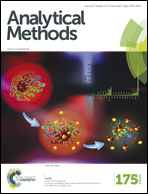Electroanalytical sensing of the antimicrobial drug linezolid utilising an electrochemical sensing platform based upon a multiwalled carbon nanotubes/bromocresol green modified carbon paste electrode†
Abstract
The electroanalytical sensing of linezolid (LIN) is explored utilising an electrochemical sensing platform based upon a multiwalled carbon nanotubes (MWCNTs)/bromocresol green (BCG) modified carbon paste electrode (MWCNT/BCG/CPE). Cyclic voltammetry, differential pulse voltammetry, chronoamperometry, electrochemical impedance spectroscopy (EIS) and scanning electron microscopy techniques are all used to characterise the properties of the electrochemical sensor. The synergetic effects of BCG and MWCNTs result in an electrocatalytic-type response providing a significantly improved electroanalytical response compared to a bare unmodified CPE. Additionally, the MWCNT/BCG/CPE sensing platform outperforms electrochemical sensors previously reported in the literature with a larger linear response and lower limit of detection. The MWCNT/BCG/CPE electrochemical sensing platform was evaluated towards the sensing of LIN where a linear range from 5.00 × 10−8 to 1.45 × 10−4 mol L−1 with a good linearity and high correlation (0.9968) was observed with the limits of detection and quantification found to correspond to 7.57 × 10−9 and 2.50 × 10−8 mol L−1 respectively. The proposed sensor was applied to the determination of LIN in the presence of cefixime trihydrate (CEF) which are both found in combined dose tablet formulations. The sensor was shown to be successfully applied to the determination of LIN in a pharmaceutical formulation and human urine and saliva samples with satisfactory recoveries. The proposed electrochemical sensing platform is simple and inexpensive and has the potential to be applied to clinical analysis, quality control and the routine determination of drugs in pharmaceutical formulations.


 Please wait while we load your content...
Please wait while we load your content...